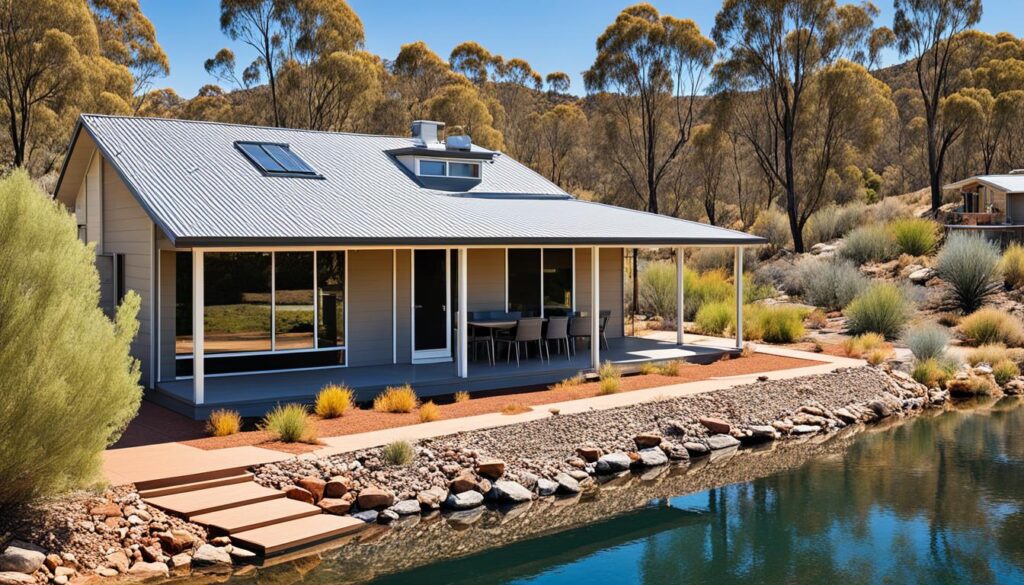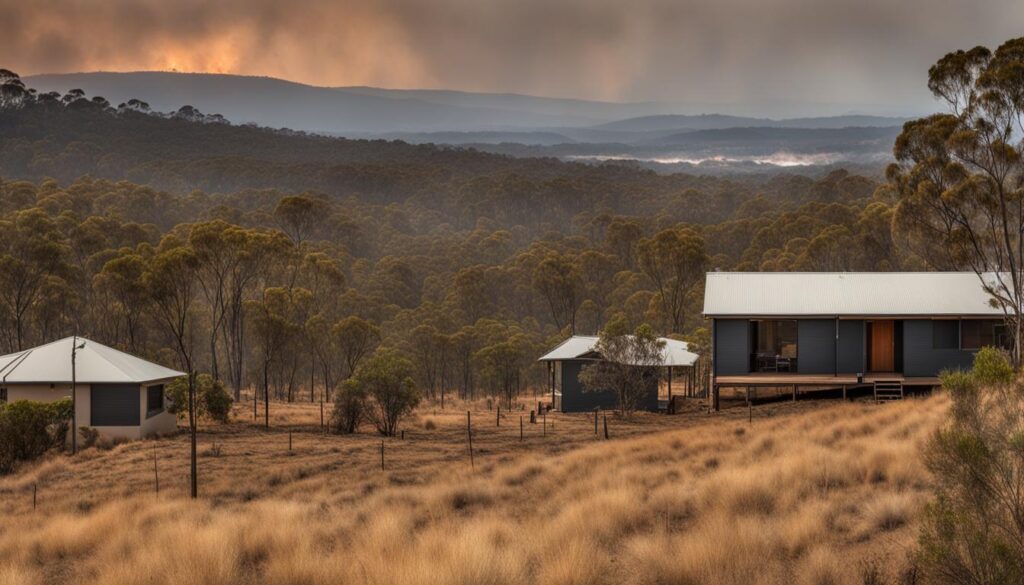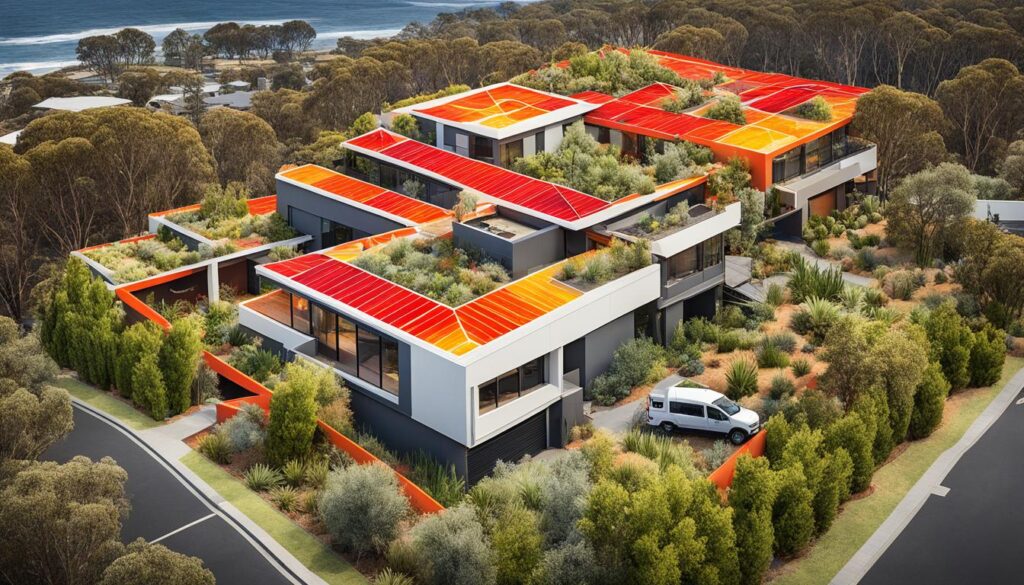In this article, we will explore an important aspect of Victoria’s Building Regulations – understanding Bushfire Attack Levels (BAL). As building in bushfire-prone areas requires careful consideration and compliance with specific regulations, it is vital to have a clear understanding of BAL ratings and their significance. By delving into the world of BAL, we can ensure effective bushfire mitigation and the safety of our structures.
Key Takeaways:
- Understanding BAL ratings is crucial for effective bushfire mitigation in construction projects.
- Victoria’s Building Regulations outline specific guidelines for BAL assessment and compliance.
- A BAL assessment considers factors such as vegetation, slope, and proximity to potential bushfire sources.
- BAL ratings help builders and homeowners make informed decisions about bushfire protection measures.
- Engaging professionals for BAL compliance ensures accurate assessments and adherence to regulations.
What are Bushfire Attack Levels (BAL)?
In this section, we will provide an overview of the concept of Bushfire Attack Levels (BAL). Understanding BAL is crucial for assessing the risk of bushfire attack on buildings and ensuring compliance with bushfire regulations. Let’s delve into the details.
Bushfire Attack Levels (BAL) are a set of ratings used to measure the potential impact and risk of bushfire on a property or building. These ratings take into account various factors such as vegetation, slope, and proximity to potential sources of bushfire.
BAL ratings play a significant role in determining appropriate construction measures and requirements in bushfire-prone areas. They provide valuable guidance to builders, architects, and homeowners in developing effective strategies to mitigate the risk of bushfire damage.
The assessment of BAL ratings is governed by bushfire regulations and guidelines to ensure the safety and resilience of buildings. In Victoria, specific regulations are in place to manage bushfire risk, including the need for BAL assessments in designated bushfire-prone areas.
The BAL ratings serve as a valuable tool for evaluating the potential danger and vulnerability of structures to bushfire attack, enabling better-informed decision-making during the planning and design phases of construction projects.
Accurate BAL assessment involves considering various factors such as the type of vegetation surrounding the building, the slope of the land, and the distance to potential sources of bushfire. By evaluating these factors, experts can assign an appropriate BAL rating to a property.
Understanding the BAL rating is important as it determines the level of bushfire protection measures required for a building. Depending on the BAL rating, specific construction standards, materials, and design features may be necessary to enhance the building’s resilience to bushfire events.
The table below provides an overview of the different BAL ratings and their corresponding descriptions:
| BAL Rating | Description |
|---|---|
| BAL-LOW | Low risk of bushfire attack |
| BAL-12.5 | Increased risk of ember attack and burning debris |
| BAL-19 | Increased risk of ember attack, burning debris, and radiant heat |
| BAL-29 | Increased risk of ember attack, burning debris, radiant heat, and potential flame contact |
| BAL-40 | High risk of ember attack, burning debris, radiant heat, and potential flame contact |
| BAL-FZ | Extreme risk of ember attack, burning debris, radiant heat, and direct flame contact |
As the BAL rating increases, the level of bushfire attack and risk also escalates. It is essential to consider these ratings when designing and constructing buildings in bushfire-prone areas to ensure adequate protection and compliance with bushfire regulations.
Importance of BAL Ratings in Construction
In construction projects, particularly in bushfire-prone areas, understanding and considering BAL ratings is of utmost importance. BAL ratings play a crucial role in assessing the potential risks associated with bushfire attacks on buildings. Failure to appropriately assess and address these risks can lead to severe consequences.
During the planning and design phases, it is essential to thoroughly evaluate the bushfire risk of an area by conducting a comprehensive bushfire risk assessment. Incorporating BAL ratings into this assessment ensures that the necessary precautions and mitigations are implemented to protect the building and its occupants.
“Understanding the BAL rating is the first step towards successful bushfire protection.”
By considering BAL ratings, architects, builders, and homeowners can make informed decisions regarding the design, materials, and construction methods that should be employed. This enables them to create buildings that are resilient to bushfire events, enhancing safety and reducing the potential for damage.
Ignoring or inadequately assessing the BAL rating can result in significant risks and vulnerabilities. Buildings with inappropriate levels of protection may be unable to withstand the intense heat, ember attacks, and radiant heat exposure during a bushfire, leading to devastating consequences.
It is crucial to remember that building in bushfire-prone areas requires complying with BAL guidelines and regulations. By doing so, the construction industry can effectively mitigate the risk of bushfire attacks and ensure the safety of both the structure and its occupants.
Therefore, by prioritizing BAL ratings in construction projects, builders and homeowners can proactively address bushfire risks, protect assets, and contribute to the overall resilience of bushfire-prone areas.

BAL Guidelines and Regulations in Victoria
In Victoria, builders and developers must adhere to specific guidelines and regulations set forth by the Victoria Building Regulations when constructing in bushfire-prone areas. These regulations aim to ensure the safety and resilience of buildings in the face of potential bushfire attacks.
The Key Provisions
The Victoria Building Regulations outline several key provisions that builders and developers need to consider when it comes to Bushfire Attack Levels (BAL). These provisions include:
- The requirement for a BAL assessment to determine the appropriate level of bushfire protection for the site.
- The classification of BAL levels based on the risk of bushfire attack.
- The establishment of construction requirements and compliance measures according to the determined BAL level.
- The need for appropriate structural design, materials, and landscaping strategies to minimize the impact of bushfire attacks.
By following these provisions, builders can ensure that their constructions meet the necessary safety standards and are better equipped to withstand bushfire events.
Compliance Measures
In order to comply with the Victoria Building Regulations, builders and developers must undertake several compliance measures:
- Engaging qualified assessors and consultants to conduct accurate BAL assessments according to the guidelines.
- Implementing appropriate construction methods and materials as specified for the determined BAL level.
- Ensuring proper design features, such as ember protection and radiant heat exposure, are incorporated into the construction.
- Following specified vegetation management guidelines to mitigate the risk of bushfire spread.
Complying with these measures is crucial to ensure that buildings in bushfire-prone areas are well-prepared and resilient against potential bushfire attacks.
BAL Guidelines
The BAL guidelines in Victoria provide comprehensive instructions for builders and developers to follow. These guidelines cover various aspects, including:
| Aspect | Guidelines |
|---|---|
| BAL Assessment | Details the process of assessing BAL levels for a particular site and determining the appropriate construction requirements. |
| Construction Methods | Outlines the construction methods and materials suited for different BAL levels to enhance the building’s resistance against bushfire attacks. |
| Vegetation Management | Provides guidance on managing vegetation around the building to reduce fire risks. |
| Building Design | Highlights the design considerations, such as ember protection and radiant heat exposure, necessary to fortify the building against bushfires. |
By following these BAL guidelines, builders and developers can ensure that their constructions are in compliance with the regulations and are adequately protected against bushfire events.
With the BAL guidelines and regulations in place, the Victorian building industry is well-equipped to address the challenges posed by bushfires in bushfire-prone areas. By adhering to these guidelines and regulations, builders can enhance the safety and resilience of buildings, contributing to the overall protection of lives and properties.
Conducting a BAL Assessment
In order to effectively assess the bushfire risk associated with a particular site, conducting a BAL assessment is vital. This assessment takes into account various factors and criteria, including vegetation, slope, and distance to potential bushfire sources. By thoroughly evaluating these elements, builders and homeowners can make informed decisions to enhance the safety and resilience of their structures.
During the BAL assessment process, the following aspects are considered:
- Vegetation: The type and density of vegetation surrounding the site play a crucial role in determining the potential severity of a bushfire. Areas with dense, highly flammable vegetation pose a higher risk and may result in a higher BAL rating.
- Slope: The steepness of the land can impact the rate at which a fire can spread. Steeper slopes make it more challenging to control the spread of a bushfire, increasing the overall risk.
- Distance to potential bushfire sources: Proximity to potential sources of fire, such as bushland, can significantly influence the bushfire risk. The closer a structure is to these sources, the higher the potential risk.
By carefully considering these factors, builders and homeowners can gain valuable insights into the level of bushfire risk associated with their site. This enables them to make informed decisions about implementing appropriate bushfire protection measures to mitigate the potential impact of a fire.
Remember, compliance with bushfire regulations and conducting a thorough BAL assessment are essential steps in ensuring the safety and resilience of buildings in bushfire-prone areas.

| Factors Considered in BAL Assessment | Impact on Bushfire Risk |
|---|---|
| Vegetation | High density and flammability increase the risk |
| Slope | Steep slopes make fire spread faster |
| Distance to potential bushfire sources | Proximity to fire sources increases the risk |
Understanding BAL Ratings and Categories
When it comes to bushfire risk assessment, understanding Bushfire Attack Levels (BAL) ratings is crucial. These ratings determine the level of bushfire attack that a building may face, allowing builders and homeowners to make informed decisions about appropriate bushfire protection measures.
BAL ratings are divided into several categories, each indicating a different level of risk. The higher the BAL rating, the more extreme the potential bushfire attack. Let’s delve deeper into these ratings and their significance:
BAL-LOW
The BAL-LOW rating represents the lowest level of bushfire attack. Buildings with this rating have a low risk of ember attack and do not require specific construction safeguards. However, it is important to note that the BAL-LOW rating still implies a risk of bushfire, albeit relatively low.
BAL-12.5
The BAL-12.5 rating indicates a moderate risk of ember attack and burning debris. Buildings with this rating require extra precautions to minimize the risk, such as sealing openings where embers can enter and using non-combustible materials for external walls and roofs.
BAL-19
Buildings with a BAL-19 rating are at a higher risk of ember attack and exposure to radiant heat. To mitigate this risk, additional measures such as installing ember screens on windows and doors, ensuring gaps are sealed, and using fire-resistant materials may be required.
BAL-29
The BAL-29 rating signifies a high risk of ember attack, radiant heat exposure, and potential flame contact. Buildings with this rating need comprehensive protection measures, including robust construction materials, ember-resistant vents, and fire-resistance measures for all external components.
BAL-40
Buildings with a BAL-40 rating face a very high risk of ember attack, radiant heat, and direct flame contact. The construction of these buildings needs to incorporate more stringent measures, such as sealed entry points, ember-resistant windows, and fire-resistant cladding.
| BAL Rating | Risk Level | Required Protection Measures |
|---|---|---|
| BAL-LOW | Low | No specific construction safeguards required |
| BAL-12.5 | Moderate | Sealing openings, non-combustible materials |
| BAL-19 | High | Ember screens on windows, sealed gaps, fire-resistant materials |
| BAL-29 | Very High | Robust construction materials, ember-resistant vents, fire-resistance measures |
| BAL-40 | Extreme | Sealed entry points, ember-resistant windows, fire-resistant cladding |
It is essential to consider the BAL rating of a building site during the design and construction stages. Adhering to the necessary protection measures ensures the safety and resilience of structures in bushfire-prone areas.
Next, we will explore the various bushfire mitigation measures recommended by the BAL guidelines, providing further insights into safeguarding buildings against bushfire events.
Bushfire Mitigation Measures
In order to minimize the impact of bushfire attacks on structures, it is crucial to implement effective bushfire mitigation measures. By following the BAL guidelines, builders and homeowners can make informed decisions on building design features, materials, and landscaping strategies.
There are a range of options available to enhance the resilience of buildings against bushfires. Some key bushfire mitigation measures include:
- Building Design Features:
- Integrating ember protection systems, such as ember-resistant vents and screens, to prevent ember entry into the building.
- Using non-combustible construction materials for external walls, roofs, and windows to reduce the risk of fire spread.
- Installing fire-resistant shutters or screens on windows to protect them from radiant heat.
- Maintaining a well-maintained and regularly cleared buffer zone around the building, free of flammable vegetation.
- Using fire-resistant plant species in landscaping and ensuring appropriate spacing between vegetation and buildings.
- Installing sprinkler systems to create a moist zone around the building during bushfire events.
- Using fire-rated materials for fences, decks, and other outdoor structures to prevent fire spread.
- Applying fire-resistant coatings or treatments to timber elements to improve their fire resistance.
- Implementing proper seals and screens on openings to prevent ember entry.
These bushfire mitigation measures should be customized based on the specific BAL rating of the area and the unique characteristics of the site. Consulting with professionals experienced in BAL compliance can provide valuable insights into the most suitable mitigation strategies for a particular building project.

“Effective bushfire mitigation measures can significantly reduce the risk of damage and loss of life during a bushfire event. By implementing the recommended strategies, we can create safer and more resilient communities in bushfire-prone areas.”
Implementing a combination of these bushfire mitigation measures can significantly enhance the safety and resilience of buildings in bushfire-prone areas. By following the BAL guidelines and considering the specific needs of the site, builders and homeowners can contribute to the overall fire safety and protection of their communities.
Building Design Considerations in BAL Areas
When it comes to constructing in bushfire prone areas, there are specific design considerations that must be taken into account to enhance the resilience of buildings to bushfire events. By incorporating these key elements into the building design, architects, builders, and homeowners can mitigate the bushfire risk and ensure the safety of the structure and its occupants.
Ember Protection
Embers are a major cause of bushfire-related property damage. Therefore, it is crucial to implement measures that effectively address ember attacks. These may include:
- Installing ember-resistant screens on windows and vents to prevent ember entry.
- Ensuring roof and wall cladding materials are non-combustible or fire-resistant.
- Eliminating potential ember entrapment points, such as gaps in roof tiles, eaves, and underfloor spaces.
Radiant Heat Exposure
Radiant heat is another significant threat during bushfire events. To minimize the exposure to radiant heat, consider the following:
- Using heat-resistant glazing for windows and doors to reduce heat transfer.
- Designing adequate setback distances from potential radiation sources, such as nearby vegetation or topographical features.
- Implementing appropriate insulation measures to minimize heat conduction into the building.
Structural Integrity
Ensuring structural integrity is paramount in bushfire-prone areas. Key considerations include:
- Using fire-resistant construction materials for the building’s structure.
- Implementing robust fire-resistant construction techniques, such as sealing gaps in walls and roofs.
- Designing load-bearing structures and connections that can withstand the impact of a bushfire event.
“By incorporating ember protection, addressing radiant heat exposure, and ensuring structural integrity, buildings in BAL areas can withstand bushfire events and reduce the risk to occupants and property.”
When designing buildings in bushfire-prone areas, it is crucial to work with professionals who specialize in bushfire risk assessment and BAL compliance. Their expertise can ensure that all necessary design considerations are properly evaluated and incorporated into the construction plans.
Engaging Professionals for BAL Compliance
When it comes to building in bushfire-prone areas, ensuring compliance with BAL regulations is of utmost importance. To achieve accurate and reliable BAL assessments, it is crucial to engage professionals who specialize in this field. Qualified assessors and consultants play vital roles in guiding and assisting builders and homeowners throughout the construction process. They bring invaluable expertise and knowledge to ensure compliance with relevant bushfire regulations, thereby minimizing the risk of damage from bushfire events.
Qualified assessors are trained to conduct thorough BAL assessments, taking into account a range of factors such as vegetation, slope, and proximity to potential bushfire sources. By assessing these crucial aspects, they provide valuable insights into the level of bushfire risk associated with a specific site. Their expertise helps builders and homeowners make informed decisions about bushfire protection measures required for the proposed construction.
Moreover, consultants specializing in BAL compliance can offer valuable guidance on the specific regulations and guidelines outlined in the bushfire regulations of Victoria. They assist builders and homeowners in understanding the complex BAL rating system and its implications for construction projects. By staying up to date with the latest changes and revisions in bushfire regulations, these professionals ensure that constructions are in line with the most recent requirements.
Engaging professionals for BAL compliance also brings additional benefits throughout the entire construction process. They can provide expert advice on designing and implementing effective bushfire mitigation measures, based on the unique contextual factors of a site. This proactive approach significantly enhances the safety and resilience of buildings in bushfire-prone areas.
By working with BAL compliance professionals, builders and homeowners can have peace of mind knowing that their projects are fully compliant with bushfire regulations. This not only ensures the safety of the occupants but also contributes to the overall resilience of communities in bushfire-prone regions.
The Role of Qualified Assessors and Consultants
“Engaging qualified assessors and consultants specializing in BAL compliance is crucial for accurate risk assessment and compliance with bushfire regulations. Their expertise and guidance throughout the construction process can help ensure the safety and resilience of buildings in bushfire-prone areas.”
– Victoria Building Authorities
| Benefits of Engaging Professionals for BAL Compliance | Role and Responsibilities |
|---|---|
|
|
With the assistance of professionals specializing in BAL compliance, builders and homeowners can navigate the complexities of bushfire regulations with ease and confidence. Their expertise ensures that constructions in bushfire-prone areas are appropriately assessed and protected against the risks of bushfire events.
In the next section, we will delve into the crucial process of conducting a BAL assessment. We will explore the factors considered during the assessment and their significance in evaluating the bushfire risk associated with a site.
Conclusion
In conclusion, understanding Bushfire Attack Levels (BAL) is crucial when it comes to ensuring effective bushfire mitigation in construction projects. By adhering to Victoria’s Building Regulations and incorporating BAL guidelines, builders and homeowners can significantly reduce the risk of damage caused by bushfire events.
Conducting thorough BAL assessments is of utmost importance, as it allows for a comprehensive understanding of the bushfire risk associated with a particular site. This knowledge enables stakeholders to implement appropriate bushfire mitigation measures that enhance the safety and resilience of buildings in bushfire-prone areas.
With the guidance of BAL ratings and regulations, builders and homeowners can make informed decisions about building design considerations, materials, and landscaping strategies. These measures play a vital role in minimizing the impact of bushfire attacks and enhancing the overall protection of structures.
FAQ
What are Bushfire Attack Levels (BAL)?
Bushfire Attack Levels (BAL) represent a system used to assess the risk of bushfire attack on buildings. They are part of Victoria’s Building Regulations and help determine the appropriate bushfire mitigation measures for construction projects.
Why are BAL ratings important in construction?
BAL ratings are important in construction because they indicate the level of bushfire risk that a building may face. Understanding BAL ratings helps builders and homeowners make informed decisions about implementing bushfire protection measures and designing their structures to withstand potential bushfire events.
What are the guidelines and regulations for BAL in Victoria?
Victoria’s Building Regulations provide specific guidelines and regulations for BAL assessment. These regulations outline the provisions, requirements, and compliance measures that builders and developers need to follow when constructing in bushfire-prone areas.
How is a BAL assessment conducted?
A BAL assessment involves considering factors such as vegetation, slope, and the distance to potential bushfire sources. These criteria are evaluated to determine the appropriate BAL rating for a specific site. Professionals, known as qualified assessors, are typically engaged to conduct accurate BAL assessments.
What do BAL ratings and categories mean?
BAL ratings and categories indicate the potential level of bushfire attack that a building may face. There are six BAL ratings, ranging from low risk (BAL-Low) to extreme risk (BAL-FZ). Each rating corresponds to specific requirements for building design and bushfire protection measures.
What are some bushfire mitigation measures recommended by the BAL guidelines?
The BAL guidelines recommend various bushfire mitigation measures, including building design features, materials, and landscaping strategies. These measures aim to minimize the impact of bushfire attacks on structures, such as incorporating ember protection screens, fire-resistant materials, and maintaining vegetation-free zones around buildings.
What design considerations should be taken into account in BAL areas?
When constructing in BAL areas, specific design considerations are crucial. These include implementing features to protect against ember attack, reducing radiant heat exposure, and ensuring structural integrity. Architects, builders, and homeowners should consider these factors to enhance the resilience of their buildings to bushfire events.
Why is it important to engage professionals for BAL compliance?
Engaging professionals who specialize in BAL compliance, such as qualified assessors and consultants, is essential for accurate BAL assessments and ensuring compliance with bushfire regulations. Their expertise throughout the construction process helps ensure the safety and resilience of buildings in bushfire-prone areas.
Why is understanding BAL important in Victoria’s Building Regulations?
Understanding Bushfire Attack Levels (BAL) is crucial in Victoria’s Building Regulations because it enables effective bushfire mitigation in construction projects. By adhering to these regulations, builders and homeowners can reduce the risk of damage from bushfire events, ensuring the safety and resilience of structures in bushfire-prone areas.
